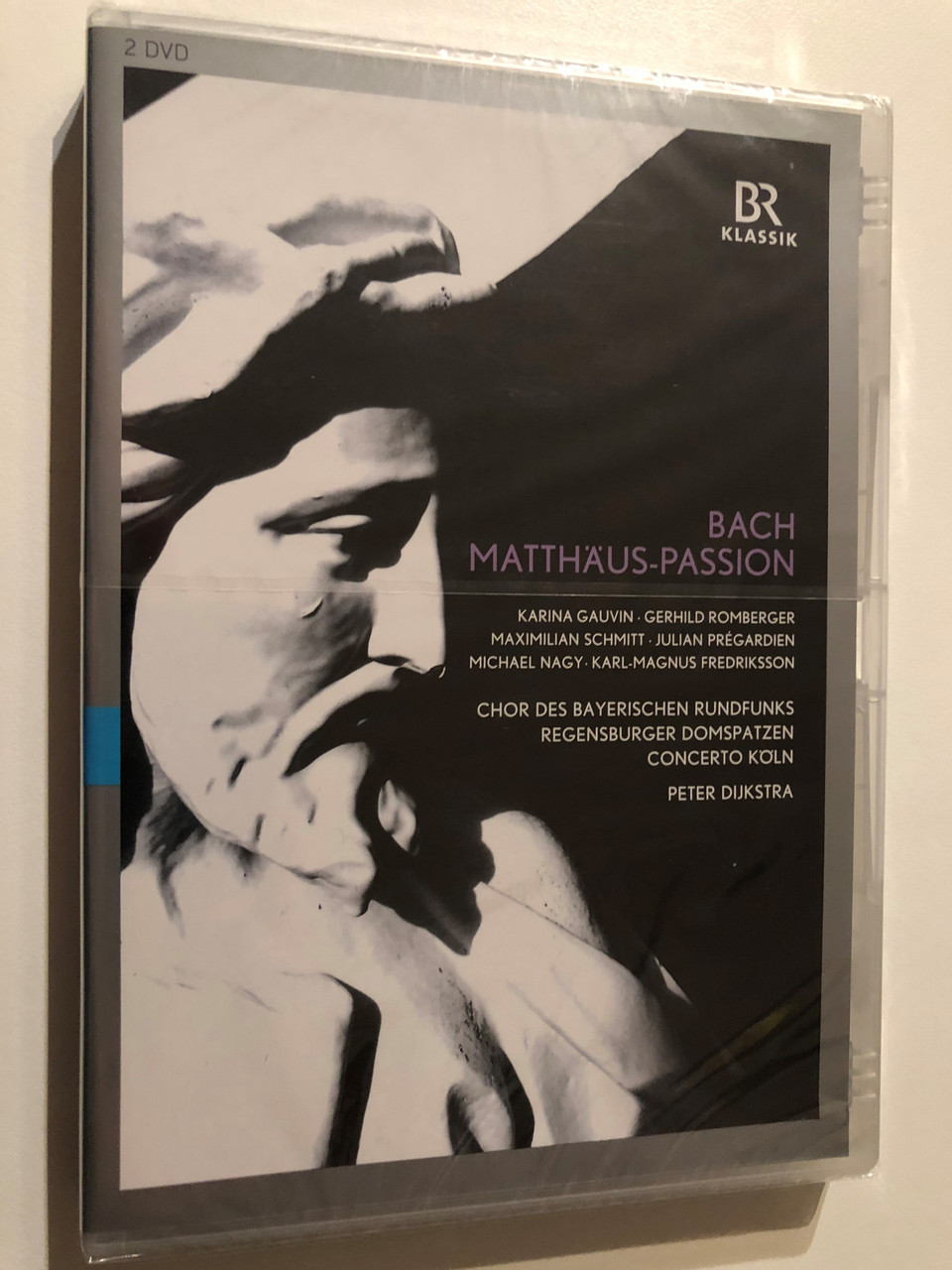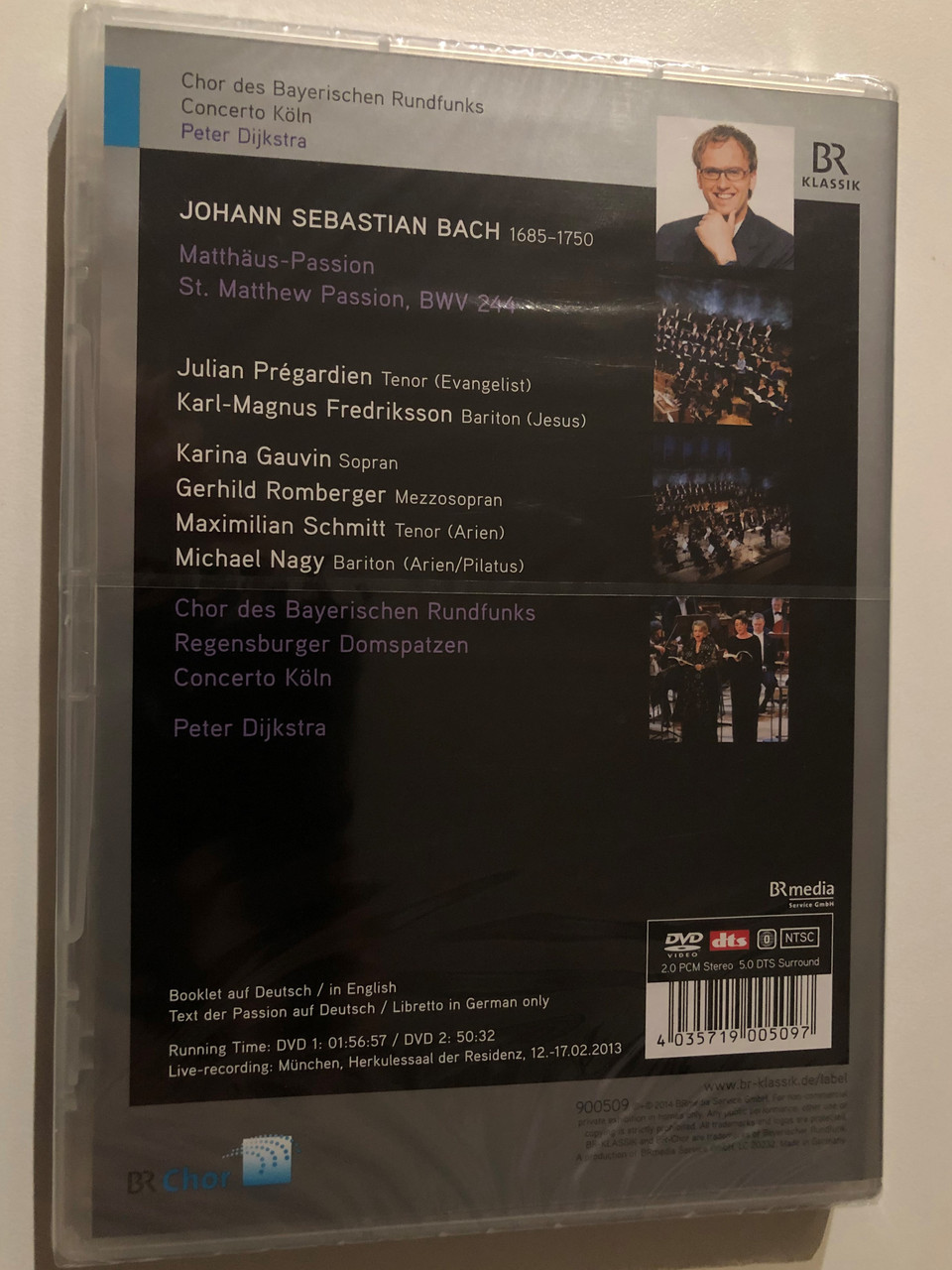Description
J.S. Bach: St. Matthew Passion, BWV 244 / BR Klassik / Chor des Bayerischen Rundfunks Regensburger Domspatzen Concerto Koln / Peter Dijkstra / Live-recording: Munchen, Herkulesaal der Residenz / 2014 DVD
Running Time: 166 minutes
UPC 4035719005097
Made in Germany
| Genre | Classical |
| Format | Classical, NTSC |
| Contributor | Karl-Magnus Fredriksson, Regensburger Domspatzen, Karina Gauvin, Julian Prégardien, Gerhild Romberger, Maximilian Schmitt, Michael Nagy, Chor des Bayerischen Rundfunks, Concerto Köln, Peter DijkstraKarl-Magnus Fredriksson, Regensburger Domspatzen, Karina Gauvin, Julian Prégardien, Gerhild Romberger, Maximilian Schmitt, Michael Nagy, Chor des Bayerischen Rundfunks, Concerto Köln, Peter Dijkstra |
| Language | German |
| Number Of Discs | 2 |
- Aspect Ratio : 16:9
- Is Discontinued By Manufacturer : No
- MPAA rating : Unrated (Not Rated)
- Product Dimensions : 5.39 x 0.67 x 7.6 inches; 2.93 Ounces
- Director : Peter Dijkstra
- Media Format : Classical, NTSC
- Run time : 2 hours and 43 minutes
- Release date : April 29, 2014
- Actors : Maximilian Schmitt, Concerto Köln, Michael Nagy, Chor des Bayerischen Rundfunks, Karl-Magnus Fredriksson
- Studio : BR Klassik
- Number of discs : 2
Product Description:
To follow the Christmas Oratorio, the Chor des Bayerischen Rundfunks and its artistic director Peter Dijkstra have issued a live recording on CD and DVD of a further major work by Johann Sebastian Bach: the St. Matthew Passion. Their instrumental partner is the renowned period instrument group Concerto Köln, who can already be heard together with the BR choir on several BR-KLASSIK CDs. The Evangelist's part is sung by the young tenor Julian Prégardien, who has made an international name for himself as an expert on interpreting Bach's Evangelist roles. The other soloists are Karina Gauvin, Gerhild Romberger, Maximilian Schmitt, Michael Nagy and Karl-Magnus Fredriksson. The concert was staged with atmospheric lighting effects, and the two choirs of solo singers of the St. Matthew Passion feature the famously clear, soaring sound of the Regensburger Domspatzen. St. Thomas's Church in Leipzig's most famous cantor composed the St. Matthew Passion in 1727 for the Good Friday service. It gives us a many-faceted and deeply moving account of the Passion according to St. Matthew. Bach's highly emotional musical language, combined with the magnificent interplay of chorales, arias and choruses on different narrative levels, makes this work quite unique.
St. Matthew Passion, BWV 244, byname of The Passion According to St. Matthew, German byname Matthäus-Passion or Matthäuspassion, Passion music by Johann Sebastian Bach. Its earliest verified performance was April 11, 1727—Good Friday—at Thomaskirche in Leipzig. It is the longest and most elaborate of all works by this Baroque master and represents the culmination of his sacred music and, indeed, of Baroque sacred music as a whole.
The St. Matthew Passion is one of hundreds of sacred pieces Bach wrote during his long tenure as director of church music and cantor of the school at Thomaskirche. The story for the work was taken mostly from the Gospel According to Matthew, but the actual verses that Bach set to music were provided by several contemporary poets. His principal contributor was Christian Friedrich Henrici, a poet who wrote under the name of Picander and also supplied the text for Bach’s secular Peasant Cantata (1742).
The St. Matthew Passion is divided into two parts, and its performance takes somewhat less than three hours. The first part concerns Jesus Christ’s betrayal, the Last Supper, and his prayers and arrest in Gethsemane. The second part presents the rest of the biblical story, including the Crucifixion, death, and burial of Christ. Throughout the work, there is more music for the four soloists—soprano, alto, tenor, and bass—than for the chorus. Often the chorus is called upon to present Bach’s new settings of existing chorales. Most prominent of those is the chorus “O Haupt voll Blut und Wunden” (“O Sacred Head Now Wounded”), which stands as 54th of the 68 sections.
The St. Matthew Passion was performed several times during the composer’s life, and a copy of its original manuscript exists in Bach’s own handwriting. However, at his death in 1750, the St. Matthew Passion, along with most Bach compositions, was forgotten. Nearly eight decades later the 20-year-old Felix Mendelssohn reintroduced the work when he conducted a 400-member chorus and a full orchestra in a 19th-century premiere at the Berlin Sing-Akadamie on March 11, 1829.


























